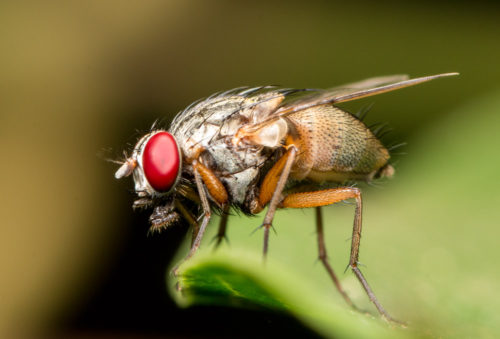
I found this flesh fly resting on a leaf in my garden. It was captured handheld on Canon EOS 70D with Canon EF 100mm f/2.8L Macro IS USM lit with Godox Ving V860c E-TTL Li-ion Camera Flash with LumiQuest SoftBox III. Flesh flies (Sarcophagidae) belong to the calyptrate flies (Calyptratae) along with house flies, blow flies and others.

Flesh flies differ from most flies in that they are ovo-larviparous, which refers to them, producing eggs that are hatched within the female, and the larvae developed or protected within the genital tract until the correct time for their emergence. This allows the gravid female to directly inject the first instar larva into the host so as to increase their chance of survival. They opportunistically deposit hatched or hatching maggots instead of eggs on carrion, dung, decaying material, or open wounds of mammals, hence their common name.

Although the name would seem to indicate a habit of breeding on vertebrate carcases, this is by no means typical for the family, which includes specialists ranging from inhabitants of pitcher plants to bat coprophages, crab saprophages, wasp nest inquilines, and insect parasitoids. Some flesh fly larvae are internal parasites of other insects such as Orthoptera, and some, in particular, the Miltogramminae, are kleptoparasites of solitary Hymenoptera like solitary bees and solitary wasps.
The family contains three subfamilies, the Miltogramminae, the Paramacronychiinae, and the Sarcophaginae, containing between them 108 genera. About 2500 species are in this family. Characteristics of the flesh-fly are its 3-segmented antennae. Most vary in size from 4 to 18 mm in length with black and grey longitudinal stripes on the thorax and checkering on the abdomen.

Flesh flies can carry leprosy bacilli and can transmit intestinal pseudomyiasis to people who eat their larvae. Flesh flies, particularly Wohlfahrtia magnifica, can also cause myiasis in animals, mostly to sheep, and can give them blood poisoning, or asymptomatic leprosy infections.
Species of this family have the potential to be used to estimate the post-mortem interval. The flesh flies are saprophagous and of great importance for the decomposition of animal matter. Thus, they are of forensic importance, especially since they prefer advanced stages of decomposition. Species of this family are almost always found in succession studies and while not as abundant as the Calliphoridae and Muscidae, they are often the most diverse on a pig or human carcases.

Additionally, the reproductive cycle of sarcophagid flies makes them prospectively more reliable for post-mortem interval estimations compared with other initial dipteran colonisers (Blow flies). Being ovo-larviparous, sarcophagids provide instantly developed immatures for corpse decomposition. By contrast, most calliphorids are oviparous, laying eggs onto a meat source, which will hatch if the correct environmental conditions are met. Sarcophagidae may be the only carrion fly larvae found on a body that is physically isolated, e.g. covered by garbage.


One of the Best Click in macro, Details are outstanding, Love to read the details you have explained.
Thanks in Tons